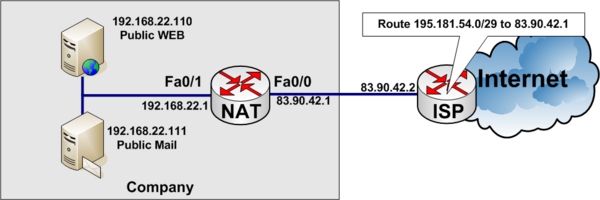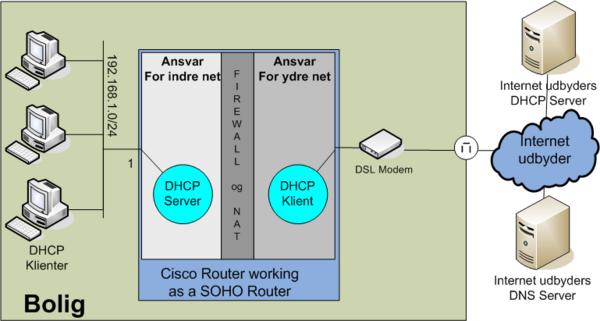Difference between revisions of "NAT Cisco IOS"
m (→debuging NAT) |
m (→Network Address Translantion) |
||
| Line 2: | Line 2: | ||
== Network Address Translantion == | == Network Address Translantion == | ||
For an explanation of NAT see Wikipedias [[Wikipedia:Network_address_translation|Network address translation]] | For an explanation of NAT see Wikipedias [[Wikipedia:Network_address_translation|Network address translation]] | ||
| − | + | == Order of operations == | |
| + | To see in which order Cisco IOS performs operations Access-list before NAT see [[Understand_the_order_of_operations_for_Cisco_IOS]] | ||
== Static NAT == | == Static NAT == | ||
Revision as of 14:09, 10 May 2009
| |
The information in this article is targeted to Cisco CCNA and CCNP curriculum, and not meant as in-depth information on all IOS |
Contents
Network Address Translantion
For an explanation of NAT see Wikipedias Network address translation
Order of operations
To see in which order Cisco IOS performs operations Access-list before NAT see Understand_the_order_of_operations_for_Cisco_IOS
Static NAT
In static NAT The Internal IP address is always translated to the same External IP address, on a one-to-one basis.
Example of static NAT
In the example below, a company has acquired an Internet connection with four additional addresses 195.181.54.0/29.
- Connection Link address to internet 83.90.42.0/30
- ISP uses 83.90.42.2/30
- Company Router 83.90.42.1/30
- The network 195.181.54.0/29 is routed to 83.90.42.1 by the ISP
- 195.181.54.1/29 is a real IP address the company wants to use to their WEB-server
- The companys WEB-server is located on the internal private network on local IP Address 192.168.22.110
- 195.181.54.2/29 is a real IP address the company wants to use to their MAIL-server
- The companys MAIL-server is located on the internal private network on local IP Address 192.168.22.111
ip nat inside source static 192.168.22.110 195.181.54.1 ip nat inside source static 192.168.22.111 195.181.54.2 ! interface fastethernet 0/0 description Connected to ISP (Outside) ip address 83.90.42.1 255.255.255.252 ip nat outside ! interface fastethernet 0/1 description Local private LAN (Inside) ip address 192.168.22.1 255.255.255.0 ip nat inside
Dynamic NAT
Dynamic nat translates internal addresses to a random pool of outside addresses.
Dymanic NAT example
Internal addresses 192.168.1.9 to 192.168.1.14 are nat'ed to outside 195.181.54.1 to 195.181.54.6 dynamically, not knowing which inside address are nat'ed to which outside address.
ip nat pool DYNAMIC-IP-POOL 195.181.54.1 195.181.54.6 netmask 255.255.255.248 ! access-list 54 permit 192.168.1.8 255.255.255.248 ! ip nat inside source list 54 pool DYNAMIC-IP-POOL ! interface FastEthernet 0/0 description Inside private network ip address 192.168.1.1 ip nat inside ! interface FastEthernet 0/1 description Outside Connection to internet ip address dhcp ip nat outside
Overloading
Overloading is often used, when you have a private internal LAN for example 192.168.1.0/24 and connect to the Internet through your ISP that lend you a Pulic IP address, through DHCP like a small SOHO router.
Overloading example 1: Connection with fixed WAN IP Address
- Internal private network: 192.168.1.0/24
- Fixed WAN IP address: 83.90.1.30/30
interface FastEthernet0/0 description Inside. Internal LAN ip address 192.168.1.1 255.255.255.0 ip nat inside ! interface FastEthernet0/1 description Outside: Internet connection to ISP ip address 83.90.1.30 255.255.255.252 ip nat outside ! ip nat inside source list 38 interface FastEthernet0/1 overload ! access-list 38 remark Permit traffic from RFC1918 private net access-list 38 permit 10.0.0.0 0.0.0.255 access-list 38 permit 172.16.0.0 0.0.15.255 access-list 38 permit 192.168.0.0 0.0.255.255
Overloading example 2: Connection with floating WAN IP Address (DHCP)
- Internal private network: 192.168.1.0/24
- WAN Address: DHCP
interface FastEthernet0/0 description Inside. Internal LAN ip address 192.168.1.1 255.255.255.0 ip nat inside ! interface FastEthernet0/1 description Outside: Internet connection to ISP ip address dhcp ip nat outside ! ip nat inside source list 38 interface FastEthernet0/1 overload ! access-list 38 remark Permit traffic from RFC1918 private net access-list 38 permit 10.0.0.0 0.0.0.255 access-list 38 permit 172.16.0.0 0.0.15.255 access-list 38 permit 192.168.0.0 0.0.255.255
Telneting or SSH'ing to the NAT outside interface
If you want to telnet or ssh to a routers outside interface.
interface FastEthernet 0/1 ip address 83.90.47.30 255.255.255.252 ip nat outside ! ip nat inside source static tcp 83.90.47.30 22 interface FastEthernet0/1 22 ip nat inside source static tcp 83.90.47.30 23 interface FastEthernet0/1 23
If you have a floating IP Address on the outside interface, you can use a loopback IP address to connect to
interface loopback 0 ip address 10.10.10.1 255.255.255.255 ! interface FastEthernet 0/1 ip address dhcp ip nat outside ! ip nat inside source static tcp 10.10.10.1 22 interface FastEthernet0/1 22 ip nat inside source static tcp 10.10.10.1 23 interface FastEthernet0/1 23
Overloading example 3: Cisco Router as a SOHO Router
- Internal private network: 192.168.1.0/24 connected to fastethernet 0/0
- WAN Address: DHCP client connected to fastethernet 0/1
NAT, PAT (overloading) and DHCP configuration. Notice firewall not configured in this example.
ip dhcp excluded-address 192.168.1.1 192.168.100.99 ip dhcp excluded-address 192.168.1.200 192.168.100.255 ! ip dhcp pool INTERNAL-NET network 192.168.1.0 255.255.255.0 domain-name jenshansen.dk default-router 192.168.1.1 import all ! interface FastEthernet0/0 description Inside. Internal LAN ip address 192.168.1.1 255.255.255.0 ip nat inside ! interface FastEthernet0/1 description Outside: Internet connection to ISP ip address dhcp ip nat outside ! ip nat inside source list 1 interface FastEthernet0/1 overload ! access-list 1 permit 192.168.1.0 0.0.0.255
Having a WEB-server on the inside network
If you want a WEB server on the internal network 192.168.1.88 to be accessed from the outside, you could issue the following nat rule.
ip nat inside source static tcp 192.168.1.88 80 interface FastEthernet0/1 80
Overlapping
Server load distribution - Load balancing between servers
You can load use nat pools to load balance between multiple IP addresses. Just remember a nat pool must be contiguous IP addresses.
Load balancing example
Load balancing between six WEB-servers to distribute the load among them.
In the real World www.tekkom.dk would for example resolve to IP Address 195.181.54.1 to which all users would connect.
In the figure below you see the company has six equal WEB-servers with the same content.
To load balance between several servers, you need to define a virtual IP address to which the users connect.
access-list 37 permit 195.181.54.1
See the full configuration below
ip nat pool WEB-SERVERS 192.168.22.9 192.168.22.14 netmask 255.255.255.0 type rotary ip nat inside destination list 37 pool WEB-SERVERS ! interface fastethernet 0/0 description Connected to ISP (Outside) ip address 83.90.42.1 255.255.255.252 ip nat outside ! interface fastethernet 0/1 description Local private LAN (Inside) ip address 192.168.22.1 255.255.255.0 ip nat inside ! access-list 37 permit 195.181.54.1
Checking and debugging NAT
current NAT translations
To show current NAT translations use show ip nat translations. See example below.
Mercantec#show ip nat translations Pro Inside global Inside local Outside local Outside global tcp 192.168.22.178:23 10.0.0.1:23 192.168.22.73:52076 192.168.22.73:52076 tcp 192.168.22.178:23 10.0.0.1:23 --- --- udp 192.168.22.178:161 80.166.167.96:161 --- --- udp 192.168.22.178:162 80.166.167.96:162 --- --- udp 192.168.22.178:68 192.168.22.178:68 192.168.22.73:67 192.168.22.73:67 icmp 192.168.22.178:512 192.168.22.178:512 58.80.117.74:512 58.80.117.74:512
debuging NAT
Be aware Debugging NAT on a heavily loaded Router could slow down the Router and overload the connection to the monitor terminal.
NOTE: To stop the debug in flight, enter no debug all and press <ENTER>. This will stop debugging. Even if you cant see the command on the screen, because of to much debugging output. It will stop.
Mercantec#terminal monitor Mercantec#debug ip nat IP NAT debugging is on TDC_SNMP# Mar 10 05:53:02.302: NAT: s=10.0.0.1->192.168.22.178, d=192.168.22.73 [34292] Mar 10 05:53:02.302: NAT*: s=192.168.22.73, d=192.168.22.178->10.0.0.1 [55215] Mar 10 05:53:03.886: NAT: s=10.0.0.1->192.168.22.178, d=192.168.22.73 [34293] Mar 10 05:53:03.986: NAT*: s=192.168.22.73, d=192.168.22.178->10.0.0.1 [55220] Mar 10 05:53:05.886: NAT: s=10.0.0.1->192.168.22.178, d=192.168.22.73 [34294] Mar 10 05:53:05.986: NAT*: s=192.168.22.73, d=192.168.22.178->10.0.0.1 [55224] Mar 10 05:53:07.886: NAT: s=10.0.0.1->192.168.22.178, d=192.168.22.73 [34295] Mar 10 05:53:07.986: NAT*: s=192.168.22.73, d=192.168.22.178->10.0.0.1 [55228] Mar 10 05:53:08.826: NAT: expiring 192.168.22.178 (10.0.0.1) tcp 23 (23) Mar 10 05:53:08.826: NAT: expiring 192.168.22.178 (192.168.22.178) tcp 17 (23)no de Mar 10 05:53:09.886: NAT: s=10.0.0.1->192.168.22.178, d=192.168.22.73 [34296]bug all Mar 10 05:53:09.986: NAT*: s=192.168.22.73, d=192.168.22.178->10.0.0.1 [55233] Mar 10 05:53:11.094: NAT*: s=192.168.22.73, d=192.168.22.178->10.0.0.1 [55235] Mar 10 05:53:11.094: NAT: s=10.0.0.1->192.168.22.178, d=192.168.22.73 [34297] Mar 10 05:53:11.194: NAT*: s=192.168.22.73, d=192.168.22.178->10.0.0.1 [55237] Mar 10 05:53:11.314: NAT*: s=192.168.22.73, d=192.168.22.178->10.0.0.1 [55238] Mar 10 05:53:11.318: NAT: s=10.0.0.1->192.168.22.178, d=192.168.22.73 [34298]


